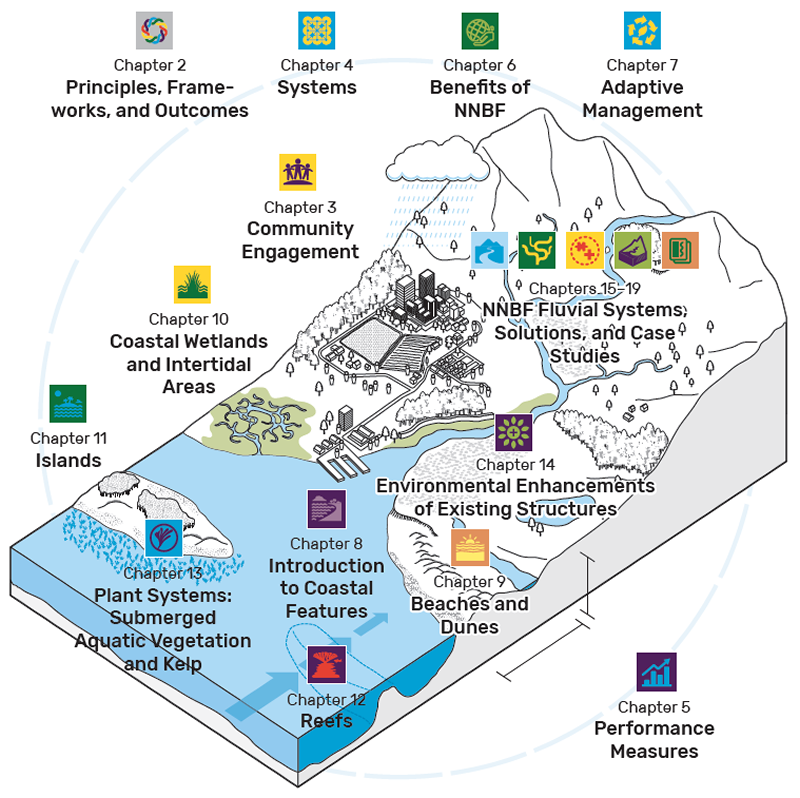Q.J. Lodder1,2, H. Pietersen1, H.de Looff1, J. de Vries1, R. Schielen1,2, R.Wilmink1
1 Rijkswaterstaat; 2 Delft University of Technology;
*corresponding author: This email address is being protected from spambots. You need JavaScript enabled to view it.
Introduction
The application of natural and nature‑based features (NNBF) has grown steadily over the past 20 years, supported by calls for innovation in flood risk management (FRM) and nature‑based solutions from many different perspectives and organizations. Technical advancements in support of NNBF are increasingly the subject of peer‑reviewed and other technical literature. A variety of guidance has been published by numerous organizations to inform program‑level action and technical practice for specific types of nature‑based solutions. However an international practitioners overview and guideline on the use of NNBF did not yet exist. The US Army Corps of Engineers (USA), the Environment Agency (ENG) and Rijkswaterstaat (NL) therefore initiated the development of such guidelines in 2016. The guidelines where published late 2021. All authors of this abstract have contributed to the guidelines. The guidelines are the product of a collaboration among 180 subject matter experts from 77 organizations and 10 countries.
Method: international guidelines
The purpose of the International Guidelines on Natural and Nature‑Based Features for Flood Risk Management (NNBF Guidelines) is to inform the use of natural systems and functions to support FRM. In these guidelines, FRM refers to actions taken to reduce future damage to people and property caused by flooding and erosion in coastal and fluvial systems, including actions to address the myriad biophysical processes that contribute to flooding and erosion (e.g., processes contributing to shoreline erosion and loss of land elevation that can increase flood risks over time). The term natural and nature-based features (NNBF) refers to the use of landscape features to produce FRM benefits. NNBF projects may also produce other economic, environmental, and social benefits known as NNBF co-benefits. These landscape features may be natural (produced purely by natural processes) or nature based (produced by a combination of natural processes and human engineering) and include such features as beaches, dunes, wetlands, reefs, and islands. Landscape features can be used alone, in combination with each other, and in combination with conventional engineering measures such as levees, floodwalls, and other structures. The type, number, size, and combinations of measures (NNBF or conventional structures) used in an FRM system depend on the context of the problem and on the geographic setting, the goals of the project, and a host of other factors. There is a need to address FRM at various, interlinked spatial and temporal scales. These scales are also related to project level (local and regional), program level (regional and national), and even policy or strategy level (national and international). The concept remains similar, but the specifics of implementation can vary.
Results
The NNBF guidelines are divided into three major sections. The first major section covers a set of common topics that are broadly applicable to NNBF. The second major section addresses coastal applications of NNBF, including open coast and estuarine environments. The third major section covers NNBF applications in fluvial or riverine environments. Throughout the document, examples and case studies illustrate the diverse contexts and progress being made in applying NNBF worldwide. The full version of the guideline is over 1000 pages, however also a summarized overview is available. Both guidelines are public domain and downloadable for free. Also introductory videos are available on the Engineering with Nature website. https://ewn.erdc.dren.mil/?page_id=4351.
In summary looking for - this year's NCK theme - international diverse approaches in Coastal Engineering & Sciences? Dive into the NNBF guidelines!

Figure 1: Contents and concepts of NNBF guidelines within a systems context. Bridges et al., 2021
References
Bridges, T. S., J. K. King, J. D. Simm, M. W. Beck, G. Collins, Q. Lodder, and R. K. Mohan, eds. 2021. International Guidelines on Natural and Nature‑Based Features for Flood Risk Management. Vicksburg, MS: U.S. Army Engineer Research and Development Center. http://dx.doi.org/10.21079/11681/41946
Bridges, T. S., J. K. King, J. D. Simm, M. W. Beck, G. Collins, Q. Lodder, and R. K. Mohan, eds. 2021. Overview: International Guidelines on Natural and Nature-Based Features for Flood Risk Management. Vicksburg, MS: U.S. Army Engineer Research and Development Center. http://dx.doi.org/10.21079/11681/41945










